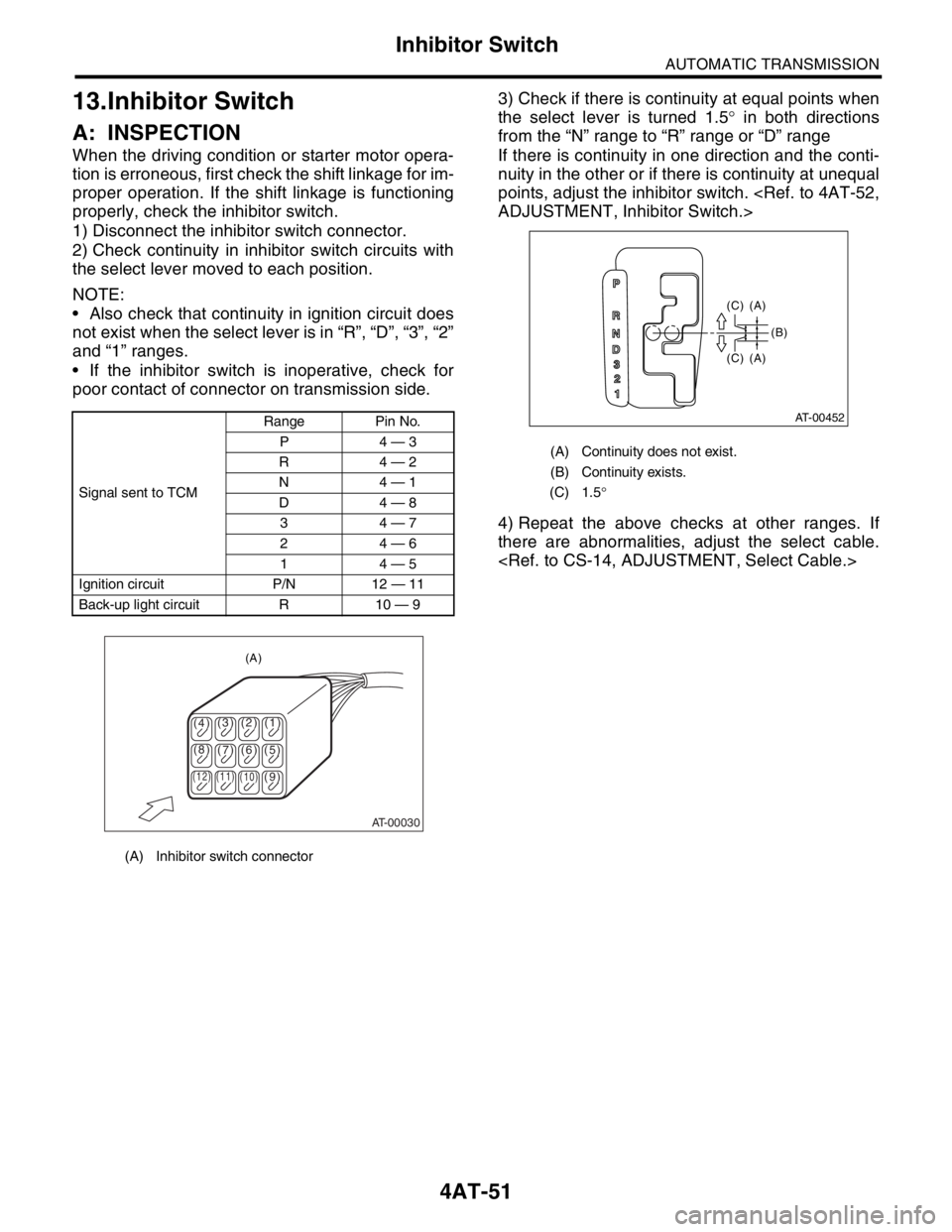2004 SUBARU FORESTER turn signal
[x] Cancel search: turn signalPage 2252 of 2870

EN(H4DOTC 2.5)-228
ENGINE (DIAGNOSTIC)
Diagnostic Procedure with Diagnostic Trouble Code (DTC)
14 CHECK SENSOR OUTPUT.
1) Read the data of sub throttle sensor signal
using Subaru Select Monitor.
2) Check the voltage change by shaking the
harness and connector of ECM, engine har-
ness connector and electronic throttle control
connector.Is the voltage 4.73 V? Go to step 15.Go to step 16.
15 CHECK POOR CONTACT.
Check the poor contact in connector between
ECM and electronic throttle control.Is there poor contact? Repair the poor
contact.Go to step 21.
16 CHECK HARNESS BETWEEN ECM AND
ELECTRONIC THROTTLE CONTROL.
1) Turn the ignition switch to OFF.
2) Disconnect the connector from ECM.
3) Disconnect the connectors from the elec-
tronic throttle control.
4) Measure the resistance between ECM con-
nector and electronic throttle control connector.
Connector & terminal
(B136) No. 18 — (E57) No. 6:
(B136) No. 29 — (E57) No. 4:
(B136) No. 35 — (E57) No. 3:Is the resistance less than 1
Ω?Go to step 17.Repair the open
circuit of harness
connector.
17 CHECK HARNESS BETWEEN ECM AND
ELECTRONIC THROTTLE CONTROL.
1) Connect the ECM connector.
2) Measure the resistance between electronic
throttle control connector and engine ground.
Connector & terminal
(E57) No. 3 — Engine ground:Is the resistance less than 5
Ω?Go to step 18.Repair the poor
contact in ECM
connector.
Replace the ECM
if defective.
18 CHECK HARNESS BETWEEN ECM AND
ELECTRONIC THROTTLE CONTROL.
1) Turn the ignition switch to ON.
2) Measure the voltage between electronic
throttle control connector and engine ground.
Connector & terminal
(E57) No. 5 (+) — Engine ground (
−):
3) Check the voltage change by shaking the
harness and connector of ECM and engine
harness connector while monitoring the value
with voltage meter.Is the voltage more than 10 V? Go to step 19.Repair battery
short circuit in har-
ness between ECM
connector and elec-
tronic throttle con-
trol connector.
19 CHECK HARNESS BETWEEN ECM AND
ELECTRONIC THROTTLE CONTROL.
1) Measure the voltage between electronic
throttle control connector and engine ground.
Connector & terminal
(E57) No. 4 (+) — Engine ground (
−):
(E57) No. 6 (+) — Engine ground (
−):
2) Check the voltage change by shaking the
harness and connector of ECM and engine
harness connector while monitoring the value
with voltage meter.Is the voltage less than 10 V? Go to step 20.Repair short circuit
in harness
between ECM
connector and
electronic throttle
control connector. Step Check Yes No
Page 2253 of 2870

EN(H4DOTC 2.5)-229
ENGINE (DIAGNOSTIC)
Diagnostic Procedure with Diagnostic Trouble Code (DTC)
20 CHECK HARNESS BETWEEN ECM AND
ELECTRONIC THROTTLE CONTROL.
1) Turn the ignition switch to OFF.
2) Remove the ECM.
3) Measure the resistance between ECM con-
nectors.
Connector & terminal
(B136) No. 18 — (B136) No. 35:
(B136) No. 29 — (B136) No. 35:Is the resistance more than 1
MΩ?Go to step 21.Repair short circuit
to sensor power
supply.
21 CHECK SENSOR OUTPUT.
1) Turn the ignition switch to OFF.
2) Connect the connectors except of the elec-
tric control throttle relay.
3) Turn the ignition switch to ON.
4) Read the data of main throttle sensor signal
using Subaru Select Monitor.Is the voltage 0.81 — 0.87 V? Go to step 22.Repair poor contact
of electronic throt-
tle control connec-
tor. Replace the
electronic throttle
control if defective.
22 CHECK SENSOR OUTPUT.
Read the data of sub throttle sensor signal
using Subaru Select Monitor.Is the voltage 1.64 — 1.70 V? Go to step 23.Repair the poor
contact in ECM con-
nector. Replace the
electronic throttle
control if defective.
23 CHECK HARNESS BETWEEN ECM AND
ELECTRONIC THROTTLE CONTROL MO-
TOR.
1) Turn the ignition switch to OFF.
2) Disconnect the connector from ECM.
3) Disconnect the connectors from the elec-
tronic throttle control.
4) Measure the resistance between ECM con-
nector and electronic throttle control connector.
Connector & terminal
(B137) No. 4 — (E57) No. 1:
(B137) No. 5 — (E57) No. 2:Is the resistance less than 1
Ω?Go to step 24.Repair the open
circuit of harness
connector.
24 CHECK HARNESS BETWEEN ECM AND
ELECTRONIC THROTTLE CONTROL MO-
TOR.
1) Connect the connector to ECM.
2) Turn the ignition switch to ON.
3) Measure the voltage between electronic
throttle control connector and engine ground.
Connector & terminal
(E57) No. 1 (+) — Engine ground (
−):
(E57) No. 2 (+) — Engine ground (
−):Is the voltage less than 5 V? Go to step 25.Repair power sup-
ply short circuit in
harness between
ECM and electronic
throttle control.
25 CHECK HARNESS BETWEEN ECM AND
ELECTRONIC THROTTLE CONTROL MO-
TOR.
1) Turn the ignition switch to OFF.
2) Disconnect the connector from ECM.
3) Measure the resistance between electronic
throttle control connector and engine ground.
Connector & terminal
(E57) No. 1 — Engine ground:
(E57) No. 2 — Engine ground:Is the resistance more than 1
MΩ?Go to step 26.Repair the short
circuit of harness.
26 CHECK ELECTRONIC THROTTLE CON-
TROL MOTOR HARNESS.
Measure the resistance between electronic
throttle control connector terminals.
Connector & terminal
(E57) No. 2 — (E57) No. 1:Is the resistance more than 1
MΩ?Go to step 27.Repair the short
circuit of harness. Step Check Yes No
Page 2264 of 2870

EN(H4DOTC 2.5)-240
ENGINE (DIAGNOSTIC)
Diagnostic Procedure with Diagnostic Trouble Code (DTC)
Step Check Yes No
1 CHECK ACCELERATOR PEDAL POSITION
SENSOR OUTPUT.
1) Turn the ignition switch to ON.
2) Read the data of main accelerator pedal
position sensor signal using Subaru Select
Monitor.
3) Check the voltage change by shaking the
harness and connector of ECM, engine har-
ness connector and accelerator pedal position
sensor connector harness.Is the voltage less than 4.8 V? Go to step 2.Go to step 3.
2 CHECK POOR CONTACT.
Check poor contact in connector between
ECM and accelerator pedal position sensor.Is there poor contact? Repair the poor
contact.Temporary poor
contact occurred,
but it is normal at
present.
3 CHECK HARNESS BETWEEN ECM AND AC-
CELERATOR PEDAL POSITION SENSOR.
1) Turn the ignition switch to OFF.
2) Disconnect the connector from ECM.
3) Disconnect the connector from the acceler-
ator pedal position sensor.
4) Measure the resistance between ECM con-
nector and accelerator pedal position sensor con-
nector.
Connector & terminal
(B136) No. 34 — (B315) No. 4:Is the resistance less than 1
Ω?Go to step 4.Repair the open
circuit of harness
connector.
4 CHECK HARNESS BETWEEN ECM AND AC-
CELERATOR PEDAL POSITION SENSOR.
1) Connect the ECM connector.
2) Measure the resistance between accelerator
pedal position sensor connector and engine
ground.
Connector & terminal
(B315) No. 4 — Engine ground:Is the resistance less than 5
Ω?Go to step 5.Repair the poor
contact in ECM
connector.
Replace the ECM
if defective.
5 CHECK HARNESS BETWEEN ECM AND AC-
CELERATOR PEDAL POSITION SENSOR.
1) Connect the ECM connector.
2) Turn the ignition switch to ON.
3) Measure the voltage between accelerator
pedal position sensor connector and engine
ground.
Connector & terminal
(B315) No. 3 (+) — Engine ground (
−):
4) Check the voltage is above the specified
value when shaking the harness and connec-
tor of ECM while monitoring the value with volt-
age meter.Is the voltage more than 6 V? Go to step 6.Repair battery
short circuit in har-
ness between
ECM connector
and accelerator
pedal position sen-
sor connector.
6 CHECK POWER SUPPLY OF ACCELERA-
TOR PEDAL POSITION SENSOR.
1) Measure the voltage between accelerator
pedal position sensor connector and engine
ground.
Connector & terminal
(B315) No. 5 (+) — Engine ground (
−):
2) Check the voltage is below the specified
value when shaking the harness and connec-
tor of ECM while monitoring the value with volt-
age meter.Is the voltage less than 4.8 V? Go to step 7.Repair short circuit
in harness between
ECM connector and
accelerator pedal
position sensor con-
nector.
Page 2270 of 2870

EN(H4DOTC 2.5)-246
ENGINE (DIAGNOSTIC)
Diagnostic Procedure with Diagnostic Trouble Code (DTC)
Step Check Yes No
1 CHECK ACCELERATOR PEDAL POSITION
SENSOR OUTPUT.
1) Turn the ignition switch to ON.
2) Read the data of sub accelerator pedal
position sensor signal using Subaru Select
Monitor.
3) Check the voltage change by shaking the
harness and connector of ECM, engine har-
ness connector and accelerator pedal position
sensor connector harness.Is the voltage less than 4.8 V? Go to step 2.Go to step 3.
2 CHECK POOR CONTACT.
Check poor contact in connector between
ECM and accelerator pedal position sensor.Is there poor contact? Repair the poor
contact.Temporary poor
contact occurred,
but it is normal at
present.
3 CHECK HARNESS BETWEEN ECM AND AC-
CELERATOR PEDAL POSITION SENSOR.
1) Turn the ignition switch to OFF.
2) Disconnect the connector from ECM.
3) Disconnect the connector from the acceler-
ator pedal position sensor.
4) Measure the resistance between ECM con-
nector and accelerator pedal position sensor con-
nector.
Connector & terminal
(B136) No. 35 — (B315) No. 6:Is the resistance less than 1
Ω?Go to step 4.Repair the open
circuit of harness
connector.
4 CHECK HARNESS BETWEEN ECM AND AC-
CELERATOR PEDAL POSITION SENSOR.
1) Connect the ECM connector.
2) Measure the resistance between accelerator
pedal position sensor connector and engine
ground.
Connector & terminal
(B315) No. 6 — Engine ground:Is the resistance less than 5
Ω?Go to step 5.Repair the poor
contact in ECM
connector.
Replace the ECM
if defective.
5 CHECK HARNESS BETWEEN ECM AND AC-
CELERATOR PEDAL POSITION SENSOR.
1) Connect the ECM connector.
2) Turn the ignition switch to ON.
3) Measure the voltage between accelerator
pedal position sensor connector and engine
ground.
Connector & terminal
(B315) No. 1 (+) — Engine ground (
−):
4) Check the voltage is above the specified value
when shaking the harness and connector of ECM
while monitoring the value with voltage meter.Is the voltage less than 6 V? Go to step 6.Repair battery short
circuit in harness
between ECM con-
nector and acceler-
ator pedal position
sensor connector.
6 CHECK POWER SUPPLY OF ACCELERA-
TOR PEDAL POSITION SENSOR.
1) Measure the voltage between accelerator
pedal position sensor connector and engine
ground.
Connector & terminal
(B315) No. 2 (+) — Engine ground (
−):
2) Check the voltage change by shaking the
harness and connector of ECM while monitor-
ing the value with voltage meter.Is the voltage less than 4.8 V? Go to step 7.Repair short circuit
in harness between
ECM connector and
accelerator pedal
position sensor con-
nector.
Page 2275 of 2870

EN(H4DOTC 2.5)-251
ENGINE (DIAGNOSTIC)
Diagnostic Procedure with Diagnostic Trouble Code (DTC)
8 CHECK SENSOR OUTPUT.
1) Connect all the connectors.
2) Turn the ignition switch to ON.
3) Read the data of main throttle sensor signal
using Subaru Select Monitor.
4) Check the voltage change by shaking the har-
ness and connector of ECM, engine harness con-
nector and electronic throttle control connector.Is the voltage less than 4.63
V?Go to step 9.Go to step 11.
9 CHECK SENSOR OUTPUT.
1) Read the data of sub throttle sensor signal
using Subaru Select Monitor.
2) Check the voltage change by shaking the har-
ness and connector of ECM, engine harness con-
nector and electronic throttle control connector.Is the voltage less than 4.73
V?Go to step 10.Go to step 11.
10 CHECK POOR CONTACT.
Check the poor contact in connector between
ECM and electronic throttle control.Is there poor contact? Repair the poor
contact.Temporary poor
contact occurred,
but it is normal at
present.
11 CHECK HARNESS BETWEEN ECM AND
ELECTRONIC THROTTLE CONTROL.
1) Turn the ignition switch to OFF.
2) Disconnect the connector from ECM.
3) Disconnect the connectors from the elec-
tronic throttle control.
4) Measure the resistance between ECM con-
nector and electronic throttle control connector.
Connector & terminal
(B136) No. 18 — (E57) No. 6:
(B136) No. 29 — (E57) No. 4:
(B136) No. 35 — (E57) No. 3:Is the resistance less than 1
Ω?Go to step 12.Repair the open
circuit of harness
connector.
12 CHECK HARNESS BETWEEN ECM AND
ELECTRONIC THROTTLE CONTROL.
1) Connect the ECM connector.
2) Measure the resistance between electronic
throttle control connector and engine ground.
Connector & terminal
(E57) No. 3 — Engine ground:Is the resistance less than 5
Ω?Go to step 13.Repair the poor
contact in ECM con-
nector. Replace the
ECM if defective.
13 CHECK HARNESS BETWEEN ECM AND
ELECTRONIC THROTTLE CONTROL.
1) Connect the ECM connector.
2) Turn the ignition switch to ON.
3) Measure the voltage between electronic
throttle control connector and engine ground.
Connector & terminal
(E57) No. 5 (+) — Engine ground (
−):
4) Check the voltage change by shaking the
harness and connector of ECM and engine
harness connector while monitoring the value
with voltage meter.Is the voltage more than 10 V? Go to step 14.Repair battery short
circuit in harness
between ECM con-
nector and elec-
tronic throttle control
connector. Step Check Yes No
Page 2279 of 2870

EN(H4DOTC 2.5)-255
ENGINE (DIAGNOSTIC)
Diagnostic Procedure with Diagnostic Trouble Code (DTC)
7 CHECK ACCELERATOR PEDAL POSITION
SENSOR.
Measure the resistance of accelerator pedal
position sensor.
Te r m i n a l s
No. 1 — No. 6:Is the resistance 0.75 — 3.15
kΩ?Go to step 8.Replace the accel-
erator pedal posi-
tion sensor.
8 CHECK ACCELERATOR PEDAL POSITION
SENSOR.
Measure the resistance of accelerator pedal
position sensor without depressing the accel-
erator pedal.
Te r m i n a l s
No. 5 — No. 4:Is the resistance 0.2 — 0.8
kΩ?Go to step 9.Replace the accel-
erator pedal posi-
tion sensor.
9 CHECK ACCELERATOR PEDAL POSITION
SENSOR.
Measure the resistance of accelerator pedal
position sensor without depressing the accel-
erator pedal.
Te r m i n a l s
No. 2 — No. 6:Is the resistance 0.15 — 0.63
kΩ?Go to step 10.Replace the accel-
erator pedal posi-
tion sensor.
10 CHECK ACCELERATOR PEDAL POSITION
SENSOR.
Measure the resistance of accelerator pedal
position sensor with the accelerator pedal
depressed.
Te r m i n a l s
No. 5 — No. 4:Is the resistance 0.5 — 2.5
kΩ?Go to step 11.Replace the accel-
erator pedal posi-
tion sensor.
11 CHECK ACCELERATOR PEDAL POSITION
SENSOR.
Measure the resistance of accelerator pedal
position sensor with the accelerator pedal
depressed.
Te r m i n a l s
No. 2 — No. 6:Is the resistance 0.28 — 1.68
kΩ?Go to step 12.Replace the accel-
erator pedal posi-
tion sensor.
12 CHECK ACCELERATOR PEDAL POSITION
SENSOR OUTPUT.
1) Turn the ignition switch to OFF.
2) Connect all the connectors.
3) Turn the ignition switch to ON.
4) Read the data of main throttle sensor signal
and sub accelerator pedal position sensor sig-
nal using Subaru Select Monitor.
5) Check the voltage change by shaking the
harness and connector of ECM, engine har-
ness connector and accelerator pedal position
sensor connector harness.Is the voltage less than 4.8 V? Go to step 13.Go to step 14.
13 CHECK POOR CONTACT.
Check poor contact in connector between
ECM and accelerator pedal position sensor.Is there poor contact? Repair the poor
contact.Go to step 19. Step Check Yes No
Page 2282 of 2870

EN(H4DOTC 2.5)-258
ENGINE (DIAGNOSTIC)
General Diagnostic Table
19.General Diagnostic Table
A: INSPECTION
1. ENGINE
NOTE:
Malfunction of parts other than those listed is also possible.
Symptom Problem parts
1. Engine stalls during idling.1) Electronic throttle control
2) Manifold absolute pressure sensor
3) Mass air flow and intake air temperature sensor
4) Ignition parts (*1)
5) Engine coolant temperature sensor (*2)
6) Crankshaft position sensor (*3)
7) Camshaft position sensor (*3)
8) Fuel injection parts (*4)
2. Rough idling1) Electronic throttle control
2) Manifold absolute pressure sensor
3) Mass air flow and intake air temperature sensor
4) Engine coolant temperature sensor (*2)
5) Ignition parts (*1)
6) Air intake system (*5)
7) Fuel injection parts (*4)
8) Crankshaft position sensor (*3)
9) Camshaft position sensor (*3)
10) Oxygen sensor
11) Fuel pump and fuel pump relay
3. Engine does not return to idle.1) Electronic throttle control
2) Engine coolant temperature sensor
3) Manifold absolute pressure sensor
4) Mass air flow sensor
4. Poor acceleration1) Manifold absolute pressure sensor
2) Mass air flow and intake air temperature sensor
3) Electronic throttle control
4) Fuel injection parts (*4)
5) Fuel pump and fuel pump relay
6) Engine coolant temperature sensor (*2)
7) Crankshaft position sensor (*3)
8) Camshaft position sensor (*3)
9) A/C switch and A/C cut relay
10) Engine torque control signal circuit
11) Ignition parts (*1)
5. Engine stalls or engine sags or hesitates at
acceleration.1) Manifold absolute pressure sensor
2) Mass air flow and intake air temperature sensor
3) Engine coolant temperature sensor (*2)
4) Crankshaft position sensor (*3)
5) Camshaft position sensor (*3)
6) Purge control solenoid valve
7) Fuel injection parts (*4)
8) Fuel pump and fuel pump relay
6. Surging1) Manifold absolute pressure sensor
2) Mass air flow and intake air temperature sensor
3) Engine coolant temperature sensor (*2)
4) Crankshaft position sensor (*3)
5) Camshaft position sensor (*3)
6) Fuel injection parts (*4)
7) Throttle position sensor
8) Fuel pump and fuel pump relay
Page 2364 of 2870

4AT-51
AUTOMATIC TRANSMISSION
Inhibitor Switch
13.Inhibitor Switch
A: INSPECTION
When the driving condition or starter motor opera-
tion is erroneous, first check the shift linkage for im-
proper operation. If the shift linkage is functioning
properly, check the inhibitor switch.
1) Disconnect the inhibitor switch connector.
2) Check continuity in inhibitor switch circuits with
the select lever moved to each position.
NOTE:
Also check that continuity in ignition circuit does
not exist when the select lever is in “R”, “D”, “3”, “2”
and “1” ranges.
If the inhibitor switch is inoperative, check for
poor contact of connector on transmission side.3) Check if there is continuity at equal points when
the select lever is turned 1.5° in both directions
from the “N” range to “R” range or “D” range
If there is continuity in one direction and the conti-
nuity in the other or if there is continuity at unequal
points, adjust the inhibitor switch.
4) Repeat the above checks at other ranges. If
there are abnormalities, adjust the select cable.
Signal sent to TCMRange Pin No.
P4 — 3
R4 — 2
N4 — 1
D4 — 8
34 — 7
24 — 6
14 — 5
Ignition circuit P/N 12 — 11
Back-up light circuit R 10 — 9
(A) Inhibitor switch connector
AT-00030
(4)(3)(2) (1)
(5) (6) (7) (8)
(9)
(10) (11) (12)
(A)
(A) Continuity does not exist.
(B) Continuity exists.
(C) 1.5°
(C) (A) (C) (A)
(B)
AT-00452
P
R
N
D
3
2
1